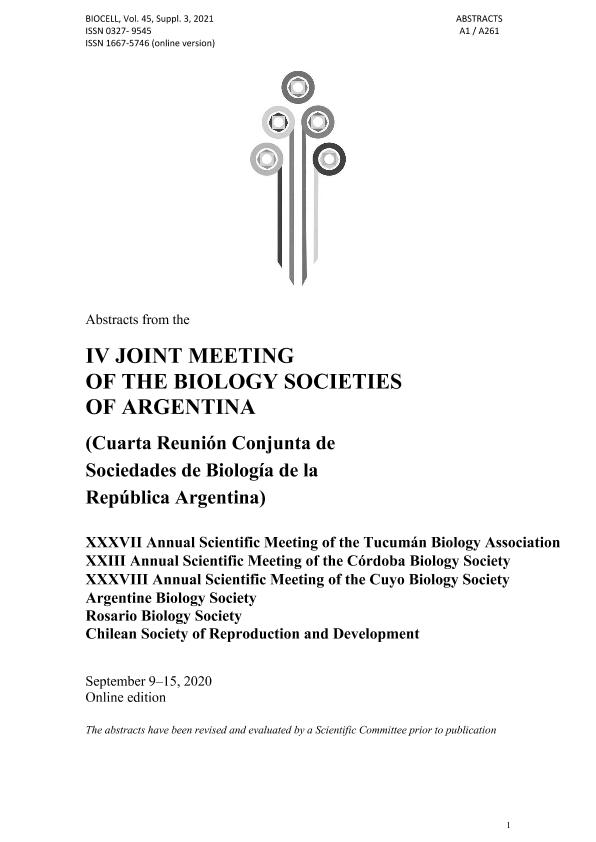Evento
Study of the protein production of Aspergillus sp. V1 using sugarcane vinasse as substrate
Tipo del evento:
Reunión
Nombre del evento:
IV Joint Meeting of the Biology Societies of Argentina
Fecha del evento:
09/09/2020
Institución Organizadora:
Asociación de Biología de Tucumán;
Sociedad de Biología de Cuyo;
Sociedad de Biología de Córdoba;
Sociedad de Biología de Córdoba;
Sociedad de Biología de Rosario;
Sociedad Argentina de Biología;
Título de la revista:
Biocell
Editorial:
Tech Science Press
Idioma:
Inglés
Clasificación temática:
Resumen
Vinasse is an acidic effluent with a high organic load, which result from ethyl alcohol production. This residue represents a potential hazard for theenvironment if not responsibly managed. Filamentous fungi can adapt to a wide variety of substrates and grow in large quantities on organic wastes.In turn, bioconversion of residues into protein-rich fungal biomass is of great interest since it can be used as an alternative nutrient source to theexpensive aquafeeds such as fishmeal and soybean meal. In a prior study, a filamentous fungus isolated from northwest of the Argentine, Aspergillussp. V1, was able to grow on sugarcane vinasse. The objective of the present work was to evaluate the protein content of Aspergillus sp. V1 biomasscultivated on vinasse, with and without supplement of exogenous nutrients. The optimal vinasse concentration for the growth of Aspergillus sp. V1was determined making dilutions of the residue in distilled water (10% to 100%, v/v) at a final volume of 10 mL. Each dilution was inoculated with1×106spores/mL and incubated at 30ºC (150 rpm) for 96 h under sterile conditions; then dry weight of biomass at 105°C was determined. Biomassproduction was carried out in 200 mL of sterile vinasse at the selected concentration, with and without supplementation of nitrogen and phosphorousin the following combinations: vinasse without nutrient supplementation (B1); vinasse supplemented with 2 g/L of (NH4)2SO4 (B2), or 2 g/L ofCO(NH2)2 (B3); vinasse supplemented with 2 g/L of (NH4)2SO4 and 1 g/L of KH2PO4 (B4), or 2 g/L of CO(NH2)2 and 1 g/L of KH2PO4 (B5). Thebiomass produced was separated by filtration, lyophilized, and weighed. In each case, percentage of total proteins (Kjeldahl-Arnold-Gunning methodusing the universal factor of conversion to protein 6.25) and productivity (in terms of milligrams of protein per liter of culture per h) was determined.The highest growth of Aspergillus sp. V1 was observed in 100% vinasse, with a biomass production of 41.55 g/L thereby following assays wereconducted witn undiluted vinasse. The weight of lyophilized biomasses was 0.89; 0.61; 2.84; 1.00 and 2.99 g/L, with protein percentages of 33%;49%; 41%; 38% and 36%, and a productivity of 3.0; 3.1; 12.0; 4.0 and 11.1 mg/L h for B1, B2, B3, B4 and B5, respectively. According to literature,aquafeeds should contain between 26% to 55% protein. In all cases, protein percentages of Aspergillus sp. V1 biomass were within the desirablerange. However, B3 was selected as the most promising biomass for future assays due to its higher productivity (12.0 mg/L h). Our findingsdemonstrate that the mycelium of Aspergillus sp. V1 grown in vinasse could be a promising and inexpensive protein source to be used as aquafeed.
Archivos asociados
Licencia
Identificadores
Colecciones
Eventos(PROIMI)
Eventos de PLANTA PILOTO DE PROC.IND.MICROBIOLOGICOS (I)
Eventos de PLANTA PILOTO DE PROC.IND.MICROBIOLOGICOS (I)
Citación
Study of the protein production of Aspergillus sp. V1 using sugarcane vinasse as substrate; IV Joint Meeting of the Biology Societies of Argentina; Ciudad Autónoma de Buenos Aires; Argentina; 2020; 117
Compartir




